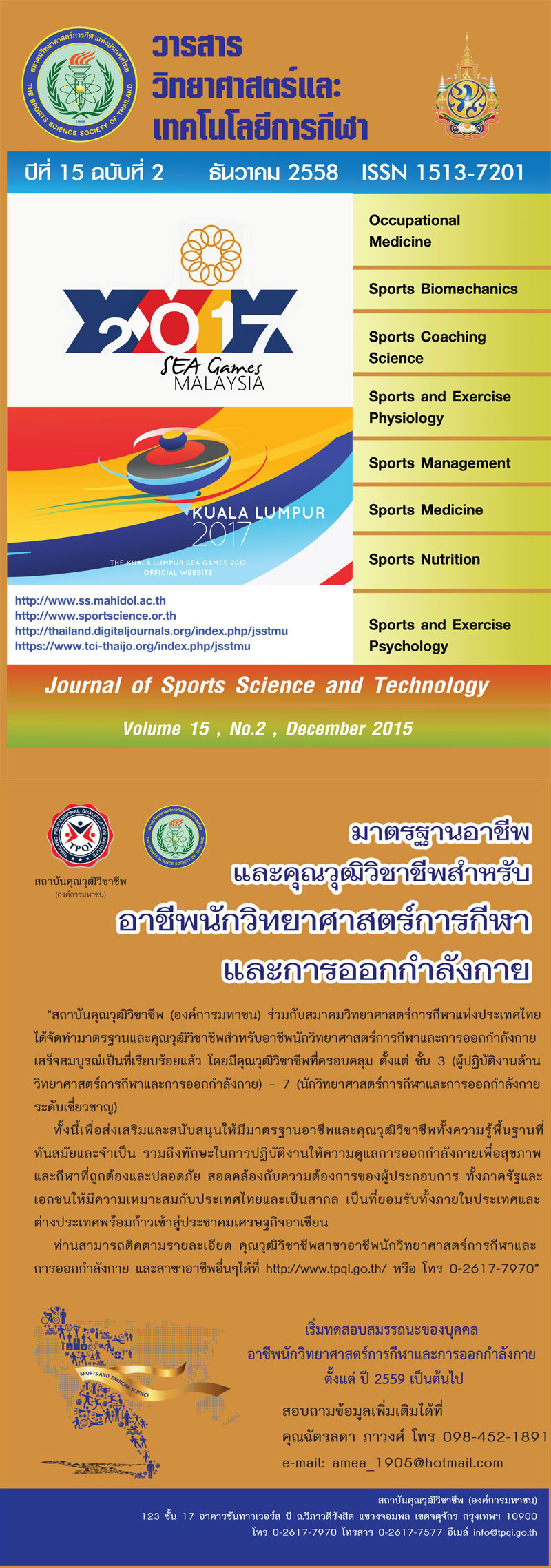THE EFFECT OF USING GUIDED IMAGERY FOR RELAXATION WITH THREE TYPE OF MUSIC ON HEART RATE, ELECTROMYOGRAPHY (EMG) AND TIME INTO A STATE OF RELAXATION IN ATHLETES
คำสำคัญ:
Guided Relaxation Imagery, Mozart Music, Thai classical Music, Natural Sound, Heart Rate, Muscle tension, time into a state of relaxationบทคัดย่อ
This research was to study the effect of using relaxing imagery with three types of music on heart rate, electromyography (EMG) of trapezius muscle and time into a state of relaxation in athletes. The participants were 40 athletes (age 18 – 22 yrs) who were experienced in sport competition and engaged in training. The subjects were selected by advertising and word of mouth. Then, a simple random sampling was used to determine the 4 groups: imagery with Mozart music, imagery with Thai classical music, imagery with natural sounds, and control group. Experimental design: participants listen to guided imagery for relaxation from an audio source from a computer. Participants listened to the guided imagery for relaxation audio for 16 minutes. Data was collected and separated into four 4-minute segments. A t-test was used to compare before and after session and ANOVA to compare time into a state of relaxation. The results found that the reduction of heart rate before and after was significant at 0.05 for all four groups. Meanwhile, electromyography measuring trapezius muscle tension showed that using Mozart music, Thai classical music and natural sound effects, the decreased heart rate before and after the experiment was significant at 0.05. However, the control group was not significant. Likewise, time into a state of relaxation found that only the Mozart music group and the Thai classical music group were significant. Therefore, the integration of the effect of imagery with music affected the heart rate, electromyography of trapezius muscle and time into a state of relaxation more effectively than imagery alone. Then this research showed the way to improve the athlete's psychophysiological state. Moreover, this research had just one session: it should be investigated over a longer period of time to observe the influence of relaxation imagery with music even more, and we need to study athlete performance in future research.(Journal of Sports Science and Technology 2015; 15(2); 389-404)
ดาวน์โหลด
เผยแพร่แล้ว
2015-12-28
รูปแบบการอ้างอิง
1.
SINGNOY C-. THE EFFECT OF USING GUIDED IMAGERY FOR RELAXATION WITH THREE TYPE OF MUSIC ON HEART RATE, ELECTROMYOGRAPHY (EMG) AND TIME INTO A STATE OF RELAXATION IN ATHLETES. J Sports Sci Technol [อินเทอร์เน็ต]. 28 ธันวาคม 2015 [อ้างถึง 12 มกราคม 2026];15(2):389-404. available at: https://he01.tci-thaijo.org/index.php/JSST/article/view/44962
ฉบับ
ประเภทบทความ
Research Article






